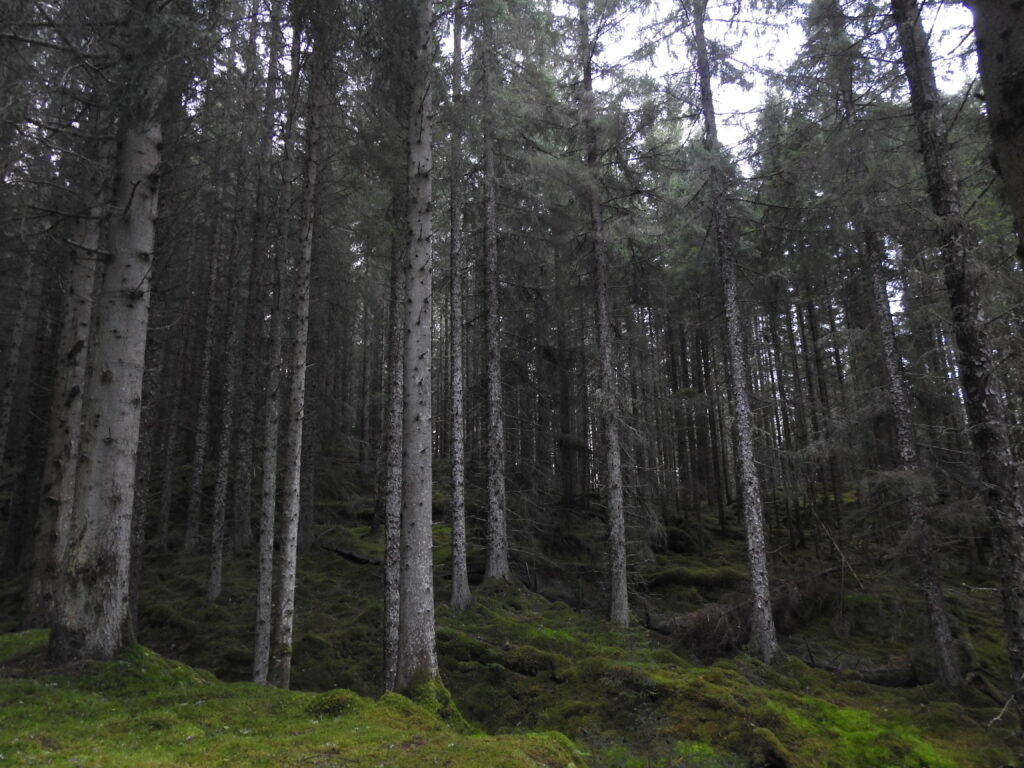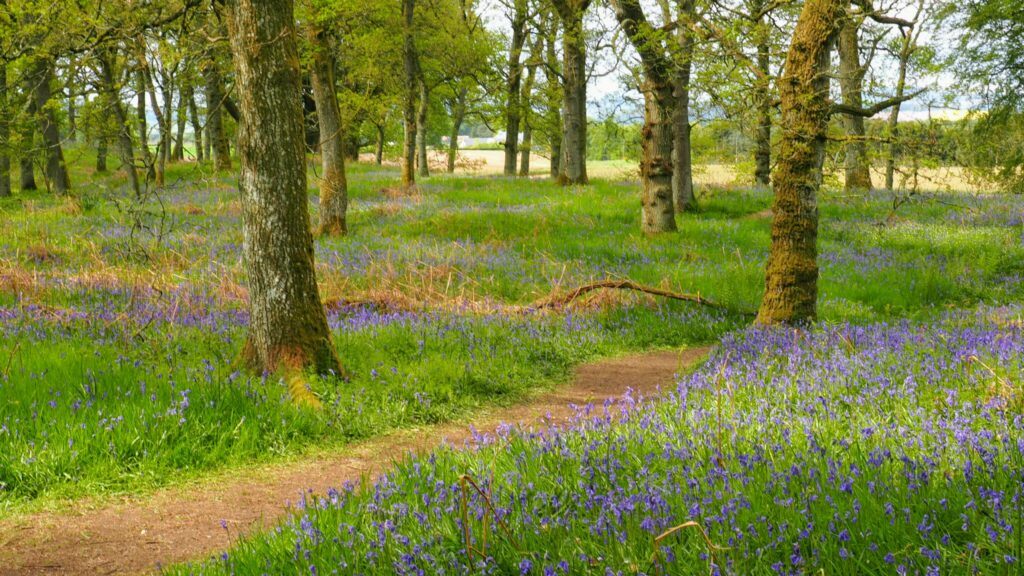Planting for the future: how public funds can drive sustainable and inclusive forestry in Scotland
By Dr Alessandro Gimona, Senior Scientist.
On Friday, the 30th of August, I took part in a panel organised by the Royal Society of Edinburgh (RSE) to promote and discuss their report, Inquiry into Public Financial Support for Tree Planting and Forestry, which examines Scotland’s push to plant more trees and considers how public funds could be best allocated to benefit society at large.
The audience was composed by a mixture of lay people, practitioners and administrators. My contribution focused on the concept of multi-functional forestry, which goes beyond carbon sequestration and provides a wide range of public benefits.
This discussion is timely, because forests are believed to play a central role in addressing the biodiversity and climate crises, and both the Scottish and UK governments have been offering grants and tax breaks to landowners to encourage tree planting, with the stated aims of combating climate change, restoring nature, and boosting the economy. However, from the RSE report, it is evident that these financial incentives may not always deliver the promised outcomes for society.
The report takes a closer look at how public money is being spent in forestry initiatives in Scotland, and, more importantly, what the public is receiving in return. It also provides clarity and evidence for the often-heard claim that plantation forests are not delivering many public benefits, despite receiving substantial public funds and tax breaks. This is a valuable opportunity to improve the efficiency and purpose of current forestry funding strategies, opening the door to more effective policies that can better serve both the environment and society.
To fully grasp this issue, however, we must first revisit the concept of public goods.

Public goods
In the world of economics, a public good is something everyone can benefit from. We are talking about resources that are both “non-excludable and non-rivalrous”, which is an elaborate way of saying that one person’s enjoyment doesn’t block anyone else from joining in.
A stunning landscape view, a beautiful sunset, the protection from floodwaters, or a thriving habitat teeming with wildlife: these are public goods that we all get to share, without taking away from anyone else’s experience.
Now, contrast that with a private good like timber in a forest. Here, the owner can exclude others from the benefits. And when trees are cut down, it’s not just the timber that disappears; the public benefits—those scenic views, the flood protection, and the wildlife haven—will vanish too.
Public goods might be vital to have, but when it comes to markets, they’re often neglected, because markets thrive on exclusivity and ownership. They love private goods—the kind you can buy, sell, and lock down, but when it comes to the public goods, markets find it difficult to put a price tag on them. In a nutshell, if you can’t keep someone from enjoying a beautiful view, flood protection, or the regulation of climate, then why should they to pay for it?
But, of course, just because something is free, it doesn’t mean it is worthless. In fact, the public goods provided by ecosystems are priceless in ways that matter most: they sustain us, inspire us, and protect us.
When markets undervalue public goods, like clean air, safe drinking water, biodiversity, or the natural beauty of a landscape, which are the backbone of our quality of life, we all pay the price and we end up with polluted air, depleted resources, and a degraded environment we have to live in.

Environmental benefits
One of the strongest arguments for public funding of tree planting and forestry is the significant environmental benefits these activities could provide, especially in countries like the UK, which have lost most of their original forest cover.
A lot, however, depends on forestry practices. Forestry practices play a crucial role in influencing biodiversity and many other benefits through various management techniques. Sustainable forest management tries to find a good balance between producing timber efficiently and keeping the forests other benefits in good shape. For example, in forests of continental Europe, techniques like selective logging, retention forestry, thinning, and coppicing, mimic natural processes like disturbance, keeping the forest’s biodiversity in tune.
In Scotland, native reforestation efforts are starting to bear fruits. In the Scottish Highlands, for example, reforested areas are seeing more and different bird species than non-forested areas. Selective logging and thinning can also help maintain tree biodiversity, if managed with care.
Commercial coniferous forests might not provide as many benefit as seminatural ones, but, with the right management, they can still play a meaningful part in promoting the well -being of humans and other species. For example, continuous Cover Forestry (CCF, i.e. clear-cut-free forestry) has shown promise in providing public benefit. Studies in Nordic countries have shown that CCF provides more public-good-type benefits than clear-cut management , and it is more beneficial for multiple species and for human recreation, while the UK experience indicates CCF might be more resilient to various forms of climate-related disturbance.
Moving further towards continuous cover forestry could also enhance public benefits at the landscape and at the local level, by improving recreational experiences like hiking and wildlife observation.
On the other hand, as the RSE report points out, silvicultural practices mainly aimed at boosting timber production and carbon sequestration, in species-poor plantations, don’t produce many public benefits and, when planted in the wrong place, can backfire by draining peaty soils, releasing more carbon that they capture and harming river ecosystems by acidifying the waters.
Our own studies shows that spatial targeting is crucial: the potential to lose more carbon from the soil than is gained by the trees is high in many upland locations, and that several publicly funded schemes are not yet carbon positive. In summary, a landscape-level approach is needed to avoid local and cumulative impacts.
Economic and Social Benefits
Forestry isn’t just about trees—it’s about breathing life into local economies and boosting social well-being. In Scotland the forestry sector currently contributes over £1 billion annually. This was also pointed out in the RSE panel debate, and it is obviously important. But, here too, the distribution of the benefits merits a closer look.
Planting, harvesting, and processing timber are keeping thousands of Scots at work. Around 7,000 full-time jobs, with another 5,000 jobs thanks to tourism and recreation activities linked to forests.
But the story doesn’t stop there. Timber processing, even when it’s just about making basic products like pallet slats and fence posts, is a job creator., with nearly 4,000 jobs.
Yet, the benefits could be further improved: the RSE report points out that if the industry pivoted toward high-value timber products for the construction industry, even more jobs could be supported. And such products are both more profitable and good for the climate (at least temporarily), as they lock in carbon for decades.
Some research highlights that rural communities often feel sidelined when it comes to the forestry industry, and that scaling down forest processing to a more local level, focused on sustainable timber production, could be a game-changer. Their local forests can sit idle for years, with little work needed. When the trees are finally harvested, outside contractors swoop in, felling the timber and hauling it off to distant processing plants. The follow-up work of restocking the forest is quick and often handled by outside crews. For the locals, this means only a small number of short-term jobs, leaving little impact on the local economy.
This disconnect between rural communities and the forestry industry is exacerbated by absentee investors who often see forests as distant reservoirs of logs, or of carbon, tapped only when needed by owners and investors who are usually far removed—sometimes even living outside the country. These absentee investors view forests as mere financial assets, subsidised in various forms by the public purse, with little incentive to change their management practices as long as their profits are secure.
These problems could be addressed by scaling activities to a more local level would mean more local jobs, more money spent in local shops, services, and businesses, bringing much-needed economic benefits to these rural areas.
Should the government subsidise Scottish Forestry then? It depends: the principle of “public money for public goods” is a guideline that underpins environmental policy in many western countries, including the US and the UK. This principle suggests that government funds should be allocated to activities that generate significant public benefits, such as environmental conservation, biodiversity enhancement, and carbon sequestration. The audience of the panel debate seemed to be in agreement. Tree planting and forestry in Scotland has great potential to benefit the public, but, as the RSE report shows, most public funding for tree planting ends up benefiting private interests rather than public goods. Grants and tax breaks are primarily directed towards private landowners and the timber industry, especially for commercial planting of non-native conifers like Sitka spruce, which, as seen above, are not the type of forest providing public goods. This approach raises land values and generates income for landowners through timber sales and carbon credits, and, especially in upland locations, with carbon rich soils, can lead to environmental damage. Therefore, this type of forestry project falls short in delivering the benefits that would justify public subsidies. This is why the RSE critiques this model, and it recommends shifting financial support away from commercial tree planting and towards projects that directly enhance public goods. This means funding well audited and monitored initiatives focused on multiple benefits such as carbon capture, biodiversity, and benefits for rural communities.
Here is where Hutton research can help: we are researching how to improve carbon and biodiversity gains while avoiding losses, how to help community inclusion, and where to plant multi-functional forests. To this end, we have made tools to simplify the complexities of where to plant trees to achieve multiple public benefits.
Conclusions
In conclusion, the RSE report underscores the critical role of government in addressing market failures and ensuring that public funds are directed toward genuine public goods rather than subsidizing private profits. Markets naturally gravitate toward maximizing private benefits, and often generate “externalities” that degrade broader societal and environmental well-being. It is the responsibility of the government to correct these imbalances by strategically allocating resources to projects that deliver a balanced mix of benefits—such as carbon sequestration, biodiversity enhancement, and community well-being—while minimizing trade-offs between them.
There was great interest in the audience and many asked questions about how to achieve that.
Hutton’s research cannot do it all but is certainly aligned with several of the RSE’s recommendations. By developing strategies that optimize biodiversity, carbon storage, and social inclusion, our work offers practical tools and insights that can guide policymakers, land managers, and the forest industry in implementing more effective, multifunctional forestry projects. By adopting this approach, Scotland can better align its forestry industry with these public goals, ensuring that the benefits of public investment extend far beyond private gain, promoting a more sustainable and inclusive future for all.
Disclaimer: The views expressed in this blog post are the views of the author, and not an official position of the institute or funder.
